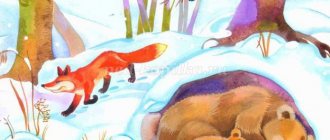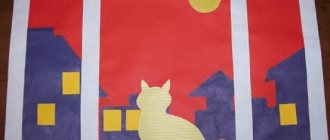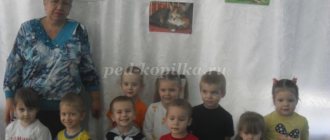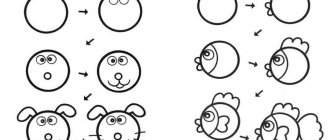Conversation on the topic “Pets” in the senior group
Summary of a conversation about pets in the senior group of a kindergarten with a presentation
Compiled by: Vitskova Marina Viktorovna, teacher of the MBDOU "Kindergarten "Golden Fish" of the Astrakhan region, Chernoyarsk district. This material will be useful for educators when conducting thematic conversations about pets with children of senior preschool age. Goals: to expand and enrich children's ideas about pets. Educational objectives: To form in children basic ideas about pets (cat, dog, cow, goat, sheep, horse, pig)
;
teach to listen carefully to the teacher, answer questions Developmental: develop the imagination, curiosity, memory and thinking of children; increase children's speech activity; develop the ability to answer questions; Educational: cultivate a sense of care and love for your pet, a sense of responsibility for your pet; cultivate an attentive attitude towards animals and a desire to help adults in caring for them. Equipment: Laptop, wall newspaper with photographs and drawings of pets. Preliminary work: conversation about animals, looking at illustrations and photographs on the topic: “Pets,” preparing creative stories together with parents about their pets.
Progress of the conversation
Teacher. Hello children. Listen to the poem, and then you will know what we will talk about today. Poem.
Everyone in the world has friends, Furry friends.
Dogs, cats, hamsters. You can't live without friends. And I have Vaska, a cat, He is the smartest cat. When I come home. He's waiting at the gate. Educator. Guys, what is this poem about? Children. About animals. Educator. What animals? Name it? Why are they called pets? Children's answers. Educator. Can you name any other pets? What animals are near you? Children. Cow, sheep, goat, rabbit, pig, horse. (Show pictures on the screen) Educator. Well done, children. Let's talk about pets today. Educator. Pets are animals kept by humans. He provides them with shelter, food, takes care of them, and they, in turn, benefit him. Do you know what benefits do pets bring? Tell me? Children's answers. Educator. Domestic animals provide humans with: milk, meat, wool. Guys, what do you think, if you release a pet into nature, can it survive there? Children's thoughts. Educator. Pets have been living next to humans for a long time, so they cannot do without his help. They have forgotten how to get their own food, build housing and defend themselves from enemies, as other animals can do. What are their names? Children. They are called wild animals. Educator. That's right, well done! How is the life of wild animals different from the life of domestic animals? Children. Wild animals take care of themselves; they live in the forest. Educator. An animal does not always bring any benefit, but a person loves and cares for it. Children, tell me, what pets do you have? Tell us about your favorite animal. How do you care for them? The didactic game “Confusion” is being played. Goals: to develop auditory attention and coherent speech. Progress of the game.
The teacher invites the children to listen to the sentence and correct the mistake.
For example: The cat lives in a kennel. The cat lives in the house. The horse lives in a pigsty. The horse lives in a stable. Educator. Well done, children, so we figured out where pets live. Now guess what riddles . Riddles Even on an iron roof He walks quietly, quieter than a mouse. He goes out hunting at night and sees everything around him perfectly. Children. Cat Nose - with a round snout, And the perky tail - with a hook. Mom is a pig, dad is a pig. He is their favorite son. Children. Piglet I'll tell you: “Me-me-me! Get ready for winter! Quickly cut my wool and knit some socks for yourself!” Children. Goat I have known you for a long time, I say: “Be-be-be!” I have cool horns, legs in hoof shoes. Children. The lamb is a faithful friend to Man, I sensitively hear every sound. I have an excellent sense of smell, a keen eye and keen hearing. Children. Dog I make my way along the fence, I go out to hunt. The mice hid in holes, I watch them for a long time. Children. Cat Physical school is being held The horse is walking across the bridge in small steps... We can do this too. (Children pretend to be horses, run in one direction at a trot, then at a walk.)
Now it’s time to rest, we’re tired after all.
Eat, drink and hit the road again... We can do this too. (Everyone crouches down and shows with their movements how they pour tea, stir sugar with spoons, cut sandwiches, then drink, eat, and after that (options are possible) they begin to work again.) Educator. And now we’ll play the game: “Whose? whose? whose? whose?". Based on the picture Educator. Whose paw is this? Children. This is a cat's paw. Educator. Whose ears are these? Children. (Cat's ears)
.
Educator. Whose ear? Children. (Dog ear) Summary of the conversation. Educator. Guys, what animals did we talk about today? How does a person care for them? What should you do to make your pets feel good and cozy? Children's answers. Educator. Well done, you were very active and inquisitive today.
Presentation on the topic: Pets
We recommend watching:
Summary of a thematic conversation in the senior group on the topic: Friendship Sviridov's music for children. Conversation with children of the senior group Thematic conversation for children in the senior group. Electrical appliances Summary of a lesson on cognitive development in the senior group “Pets”
Similar articles:
Conversation about courage with older preschoolers
Conversation about hard work in the preparatory group
Conversation about envy with preschoolers of the preparatory group
The most important events in the history of Russia for children 5-8 years old
About Russian heroes for children 6-7 years old
GCD move
1. Greeting ritual.
"Cheerful greeting"
. Children stand in a circle, greet neighbors on the right and left with their fingers, palms, elbows, and noses; they greet guests with an air kiss.
2. Children sit at tables and perform articulation gymnastics according to a card diagram.
3. The teacher reads riddles about pets.
It's not a bird, it doesn't sing, it lets you know who goes to the owner. (Dog)
The fur is soft, but the claw is sharp. (Cat)
Not a plowman, not a carpenter, not a blacksmith, not a carpenter, but the first worker in the village. (Horse)
A fur coat and a caftan walks across the mountains, across the mountains. (Sheep)
Source
Book for children of the preparatory group “Collection of stories about pets”
Tamara Nikolaevna Lazarchuk
Book for children of the preparatory group “Collection of stories about pets”
I would like to start my new publication with a statement from V. A. Sukhomlinsky
This valuable quality - love for books - begins to be embedded in the soul of a child from early childhood, from his family.
Modern children get acquainted with books earlier than their peers in the 20th century, but for some reason they read them much less. And as life shows, due to lack of time, and often due to a lack of understanding of the role of books in the life of a preschooler, almost 30% of parents rarely read aloud to their children or do not read at all.
Television and the computer have practically replaced books from a child’s life, and all because parents prefer to occupy him with something that does not require their personal presence.
I worked with the children of the last graduating class on the project “The role of books and family in the development of a child’s speech.” You can see the development of this project in the publication “Design technologies in educational work with preschoolers”
As part of this project, the guys and I produced the book “Collection of Stories about Pets”
The purpose of this work was:
• introducing children to book culture
• motivate children to create together – making a book with their own hands
Tasks:
Educational
• Strengthen children's knowledge about the book.
• Arouse interest in creating illustrations.
• Activate words in children’s speech: cover, page, illustration, text
Developmental
• Promote the development of imagination, the manifestation of independence and initiative, and the expression of one’s individuality.
• Develop the ability to convey the characteristics of animals
• Develop the ability to work with visual materials.
Educational
• Foster interest in joint creativity
I suggest you look at the result of our work.
Summary of an integrated lesson on ecology for children of the middle group “Autumn gatherings. Conversation about pets" Integrated lesson on ecology and applications in the middle group "Autumn gatherings. Conversation about pets"Purpose: to consolidate knowledge.Summary of GCD using ICT “How did the book appear?” for the preparatory group Summary of GCD using ICT “How did the book appear?” for the preparatory group Goal: to expand children’s knowledge about the history of its appearance.
Summary of a lesson on cognitive development in the preparatory school group "Red Book" Educational area: Cognitive development Type of educational activity: familiarization with the natural world, speech development Type of educational activity: reinforcing activity.
Summary of a lesson on speech development for a preparatory school group. Compilation of stories on the topic “Costumes of the peoples of the world” Summary of continuous educational activities with children of the preparatory group for school. Educational field "Speech development".
Red Book. Joint creativity of parents and children of the preparatory group If every person on a piece of his own land did everything he could, how beautiful our land would be! (A.P. Chekhov) Our nature created.
Literary and theatrical project “Book of fairy tales and stories by D. N. Mamin-Sibiryak” Video Project “Book of fairy tales and stories by Dmitry Narkisovich Mamin-Sibiryak” (literary and theatrical) L. V. Rybakova, music director I.V.
Project for the development of coherent speech of children of the middle group “Compilation of descriptive stories on the topic “Pets” Type of project: pedagogical. Project duration: long-term. Project participants: children of secondary group No. 3, teachers, parents.
Collection of games for children with speech impairments Automation of sounds in children with speech impairments while walking (collection of games) Games for automating whistling sounds.
Scenario for a graduation party in kindergarten for children of the preparatory group “The Magic Book” Scenario for a graduation party in kindergarten for children of the preparatory group “Magic Book” Presenter: The hall is solemnly and beautifully decorated.
Source
An educational fairy tale for a conversation about domestic animals and birds and their young
Svetlana Razdobarova
An educational fairy tale for a conversation about domestic animals and birds and their young
One day, near the yard, a cub and began calling for its mother. Suddenly he heard frogs croaking nearby. The cub thought that they were laughing at him and hurried and hurried to run into the yard. The yard turned out to be very large. The cub saw a large dog near the booth. Approaching her, the baby asked:
“What’s your name?” asked the dog.
- How can you speak?
The cub remembered how the frogs laughed at him. He walked up to the dog and said in his ear
that he could talk.
-No, you are not my cub . They are called my children. ( children's )
and they say.
(
children's ) .
went further . Near the barn he saw a goat and hurried towards it.
“Are you my mother?” asked the baby.
“What’s your name and how do you say it?” asked the goat.
“I don’t know what my name is, but I can speak like this,” the cub stood up on his paws and said in the goat’s ear what he could.
-No, you are not my child. My children's names. ( children's )
and they say.
(
children's ) So the cub walked around almost the entire yard. He found out that the cow had babies. ( children's )
and they say.
;and at the horse. and they can speak. ; at the pig. and they. (grunt)
; at the goose's. and they talk. ; at the duck's. and they can. ;at the chicken. and they say.
It was already getting dark outside, and the cub still had not found its mother. And he really wanted to eat. Suddenly, he saw a box. Running up to her, the cub stood up on his hind legs and tried to look inside.
-The master's children played with you and did not bring you back to the box. It's time to have dinner and go to bed.
cub learned from his mother that his name was kitten. And his brothers and sisters say “Meow.” After drinking the milk, the kitten curled up and fell asleep next to its mother.
Summary of a lesson on strengthening children's knowledge about domestic animals and birds “Whose feather?” Goal: to consolidate children’s knowledge about domestic animals and birds, their appearance; give an idea of the properties of a feather (soft, light); Fasten.
Summary of a conversation about pets Purpose: To generalize a specific idea about pets and form the concept of “pets.” Learn to establish essential ones.
Talk about pets to develop creative imagination. learn to find signs of similarities between pets and objects located around them. develop logical.
A comprehensive lesson on forming ideas about poultry in children of the second junior group “In the village with grandma” Goal: Continue to form ideas about poultry, know that a hen has children (chickens). Form ideas about some.
Summary of joint activities to develop knowledge about domestic animals and birds “In Grandma’s Yard” in the younger group Prepared and conducted by teacher Aksakova Tamara Anatolyevna Objectives: To consolidate children’s knowledge about domestic animals and birds, to distinguish.
Summary of a lesson to expand knowledge about domestic animals and birds “Luntik visiting children” “Luntik visiting children.” The purpose of the lesson is to expand children's knowledge about domestic animals and birds. Objectives: 1. Expand and consolidate the presentation.
"Autumn Gatherings" Lesson-conversation about pets Objectives: = consolidate children's knowledge about pets; = develop the ability to identify signs of similarity and difference between animals; = recognize animals.
GCD plan in the middle group “The World of Pets” (Part II) part 1 Day of the week date Direct educational activity Educational activity in special moments Creation/organization.
Project “World of Pets” Project type: research and creative. Project participants: children of the second junior group, teachers, music director, parents.
Project “World of Pets” Project in the second junior group “World of Pets” Relevance of the project: The animal world is an important part of our lives. Every.
Source





